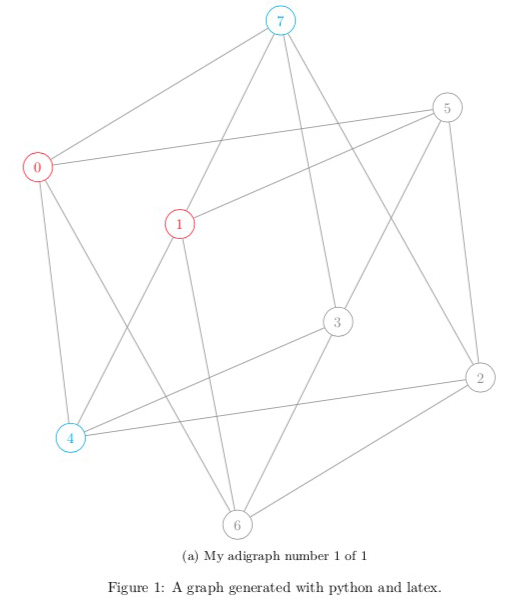Pyadigraph turns your networkx into Adigraph latex package.
Project description
Pyadigraph turns your networkx into Adigraph latex package.
The Latex generated with this package requires Adigraph (1.7.0+) and the subfigures package.
Installation
After having installed Adigraph, you can run:
pip installed pyadigraphExample
from pyadigraph import Adigraph
import networkx as nx
A = Adigraph(
vertices_color_fallback="gray!90",
edges_color_fallback="gray!90",
sub_caption="My adigraph number {i} of {n}",
sub_label="adigraph_{i}_{n}",
row_size=1,
caption="A graph generated with python and latex.",
label="pyadigraph_example"
)
A.add_graph(
nx.bipartite.random_graph(4, 4, 1),
vertices_color={
0: 'red!90',
1: 'red!90',
4: 'cyan!90',
7: 'cyan!90'
})
A.save("test/result.tex", document=True)Which when generated results in:
\documentclass{report}
\usepackage{adigraph}
\usepackage{subcaption}
\begin{document}
\begin{figure}
\begin{subfigure}{1.0\textwidth}
\NewAdigraph{myAdigraph}{
0,red!90,:-0.4386601404141742\textwidth,0.2091077552922947\textwidth:;
1,red!90,:-0.15708496776680972\textwidth,0.09630690244229406\textwidth:;
2,gray!90,:0.43887677279554366\textwidth,-0.2079924280020609\textwidth:;
3,gray!90,:0.15678823839504888\textwidth,-0.09746320565948384\textwidth:;
4,cyan!90,:-0.3736460590634439\textwidth,-0.327631363498189\textwidth:;
5,gray!90,:0.3735687548614322\textwidth,0.3275275669374224\textwidth:;
6,gray!90,:-0.042735184609099336\textwidth,-0.4998552275122768\textwidth:;
7,cyan!90,:0.0428925858015027\textwidth,0.5\textwidth:;
}{
0,4,gray!90,::;
0,5,gray!90,::;
0,6,gray!90,::;
0,7,gray!90,::;
1,4,gray!90,::;
1,5,gray!90,::;
1,6,gray!90,::;
1,7,gray!90,::;
2,4,gray!90,::;
2,5,gray!90,::;
2,6,gray!90,::;
2,7,gray!90,::;
3,4,gray!90,::;
3,5,gray!90,::;
3,6,gray!90,::;
3,7,gray!90,::;
}[]
\myAdigraph{}
\caption{My adigraph number 1 of 1}\label{adigraph_1_1}
\end{subfigure}
\caption{A graph generated with python and latex.}\label{pyadigraph_example}
\end{figure}
\end{document}And when you compile this in your document you get:
Project details
Release history Release notifications | RSS feed
Download files
Download the file for your platform. If you're not sure which to choose, learn more about installing packages.
Source Distribution
pyadigraph-0.0.1.tar.gz
(12.3 kB
view hashes)

















